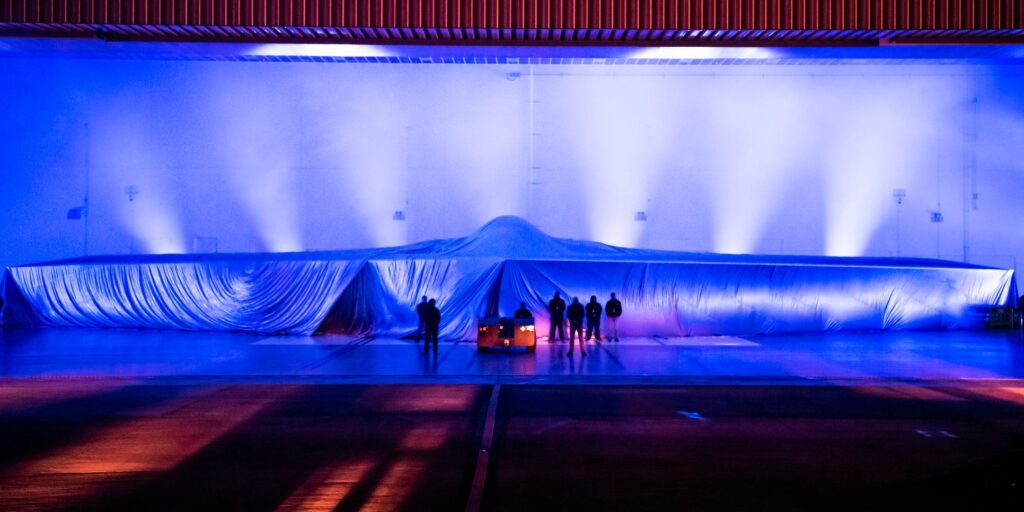- On December 2, the US Air Force unveiled the B-21 Raider, its first new bomber in over 30 years.
- Very little is known about the B-21's capabilities, and US officials plan to keep it under wraps.
- But it may be most valuable not for what it can do now but its ability to stay relevant for decades.
What is the best feature of the B-21 Raider? It may not be the new stealth bomber's range, or its payload, or even its distinctive tailless flying-wing design.
Indeed, despite the media and aviation buffs oohing and ahing over the unveiling of America's first new bomber in 34 years — a plane that Northrop Grumman described as "the world's first sixth-generation aircraft" — there is little that we know at this point about the aircraft's capabilities.
Yet the B-21's best feature may not be its current capabilities but its future ones.
"The Raider was built with an open-system architecture, which makes it highly adaptable," Secretary of Defense Lloyd Austin said at the presentation of the B-21, which took place at Northrop Grumman's plant in Palmdale, California on December 2. "So as the United States continues to innovate, this bomber will be able to defend our country with new weapons that haven't even been invented yet."
"The B-21's edge will last for decades to come," Austin added.

An ability to upgrade the B-21 with technology that doesn't exist yet could enable the bomber to remain a viable weapon for decades, in the same way that the legendary B-52 has been in service since the mid-1950s.
The B-21 isn't scheduled to make its first flight until 2023, but Northrup already boasts that it is expressly designed to keep up with changing technology.
"To meet the evolving threat environment, the B-21 has been designed from day one for rapid upgradeability," the company says. "Unlike earlier generation aircraft, the B-21 will not undergo block upgrades. New technology, capabilities and weapons will be seamlessly incorporated through agile software upgrades and built-in hardware flexibility."
In some cases, the vague promise of future military technology may just be rhetoric; in others, it could be an attempt to buy time for a failing program. The B-21 is still a long way from entering service, and officials have complemented the program, but those expecting it to be a revolutionary design may be disappointed.

Flying wings are a mature concept "that was unveiled in the 1940s," aviation analyst Richard Aboulafia told Insider. Nazi scientists developed the Horten 229, while the US also tinkered with the Northrop YB-49 flying-wing bomber.
But the B-21 project suggests a conscious belief that an aircraft is only as good as its ability to accommodate future innovations.
Indeed, a common denominator of classic warplanes — think the B-52, which is currently being upgraded, or the F-4 Phantom — is their ability to keep up with the times. With a good, adaptable basic design, new weapons, sensors and avionics can be added later.
"If the open architecture concept works, we could be looking at a plane that flies for 60, 70, or 80 years like the B-52," said Aboulafia, who is managing director at AeroDynamic Advisory.
Betting on the future

Ironically, all this suggests that while the current capabilities of the B-21 are crucial, they may not be the important ingredient in the aircraft's long-term success.
For example, range isn't the problem it once was. While the B-21's range is classified — some estimates put its reach at 6,000 miles — aerial refueling should enable the Raider to strike anywhere on the planet.
Advances in radar technology, such as anti-stealth radar, might nullify some of the B-21's stealthiness, but the Raider will also receive better jammers or improved radar-absorbing coatings.
The B-21 will also be armed with new weapons, especially new generations of stand-off weapons. The Air Force, for example, recently asked prospective developers for information about building a new air-launched stand-off missile to be fielded by 2030.

The B-21 would also seem likely to carry hypersonic weapons in the future. However, Aboulafia was skeptical that it could handle the current models: "Hypersonics would be a little too big for the B-21," which is smaller than its older cousin, the B-2 Spirit, which debuted in November 1988.
On the other hand, hypersonic missiles will also evolve. The Pentagon has already suggested that the F-15EX fighter could be armed with hypersonic weapons, while Russia has armed MiG-31 fighters with the Kh-47M2 Khinzal, which Moscow calls a hypersonic missile, for use in Ukraine.
Current hypersonic missiles are too big to fit into the bomb bay of smaller stealth aircraft like the F-35, and carrying them externally reduces the aircraft's stealthiness. But these weapons will become smaller and easier to fit on to platforms such as missile-launching cargo planes.
Buying an aircraft that costs $700 million apiece and betting on future improvements to keep it relevant is a chancy proposition. But if the B-21 is a solid design that is also adaptable, it is not impossible that we could see the Raider flying into the 22nd century.
Michael Peck is a defense writer whose work has appeared in Forbes, Defense News, Foreign Policy magazine, and other publications. He holds a master's in political science. Follow him on Twitter and LinkedIn.
